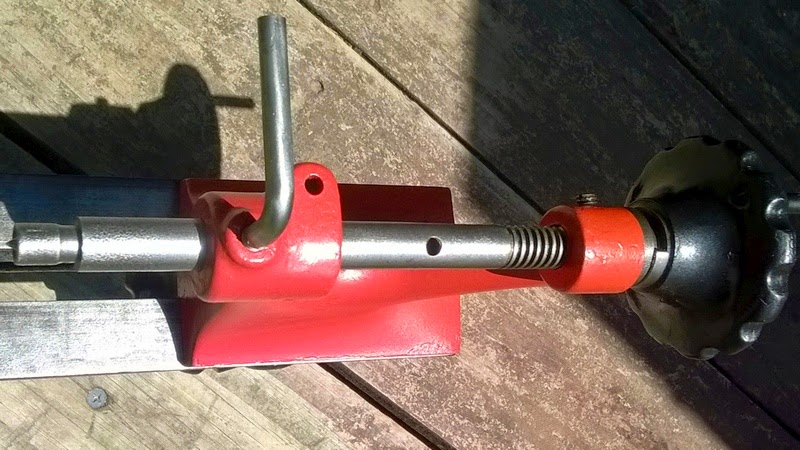A little over two years ago I bought a model 125 GP bench lathe at auction for 2 1/2 sawbucks. It is missing the original tool rest and a few other accessories and had been painted a very Christmas-y green and red.
 |
| After a cleaning |
The lathe is cast iron with milled ways. Like all things Goodell Pratt it is sturdy and built to last the ages. Model 494 was the bigger brother and was six inches longer between centers with the same swing. GP also sold a model 700 model/watch maker's lathe with a 5 inch swing and 3 1/2 inches between centers.
Model 125 Specs:
- Swing: 7 inches
- 12 inches between centers
- 1 Morse taper headstock with 1x12 threads
- 0 Morse taper tailstock
- Pulley diameters: 1 1/2, 2 1/2, 3 1/3 inches
- Overall length 25 inches
- Height 11 1/2 inches
- Weight 30 pounds
Is/Was this a good beginner lathe?
I am a product of the late 20th Century, it is impossible for me to judge the 125 fully in the context of the early 20th Century when manufacturers were still experimenting. Nowadays, 1x8 headstock threads and 2MT are expected in lathes up to medium size. The 125 is a light duty hobbyist lathe but still the 0MT tailstock taper doesn't make sense. Two tapers means duplicate accessories and the 0MT is just dinky. A 1MT on both ends would have made accessories like the drill chuck more versatile. The 7 inch swing limits use as a wood lathe and I suspect these were more commonly used as metal lathes for which they had a good variety of accessories. I found it difficult to power from a motor without considerable vibration. The height allows too much leverage if the motor is behind the lathe, and the base gets in the way if you try to mount a motor below. The design is really optimized for powering from a large treadle flywheel or from an overhead line shaft. So as a modern day beginner lathe, it misses the mark by a mile. But in context of the late 19th - early 20th Centuries, none of these things were uncommon. Consider the Millers Falls treadle lathe with it's tiny 2 1/2 inch swing, 16 inches between centers and similar design. The popular Barnes No. 4 1/2 with you guessed it -- 4 1/2 inches of swing. Early Oliver treadle lathes had 8 inches of swing, now common 1x8 spindle threads, but non-standard tapers. Styling and design is pre-Art Deco which was about to sweep the world when Goodell Pratt was purchased by Millers Falls and stopped production of this lathe.
Another feature of early lathes was that of being a multipurpose machine. GP sold a nice array of accessories: A disc sander. An outboard buffing spindle. A fret saw. And a circular saw (table saw). Not to mention an impressive variety of metalworking accessories.
So while it may have limited usefulness as a modern lathe, the 125 and its' brothers exude charm and hearken to a time when design wasn't optimized for an assembly line or retail shelf space.
Some close ups.
 |
| Headstock with three step pulley and oiling ports. |
The headstock uses a cone bearing to account for wear and has two oil ports. These are from a time before electricity was common in rural areas so there is three step pulley for the optional treadle base.
 |
| Tailstock. Missing fast action lever for drilling. |
 |
| Tailstock business end sporting a cup center with it's tiny 0MT taper. |
 |
| Stand built for the lathe |
Part 2 will be repainting the no. 125.










































